#monastic churches italy
Explore tagged Tumblr posts
Text
Crown Prince Lando AU idea based entirely on his appearance today in Italy for his trophy and Lawrence writing about how every team is courting Lando



okay so I wrote this rly fast on the work laptop and you have to just ignore the weird interpretations of how royalty and inheritance etc works. and completely fucking with how things went down in F1 history. it's an absolute mess and possibly unreadable but I literally couldn't stop myself.
if you're a fic author then pleaaaaase have a look and see if you can take this and actually make anything out of it even if it needs a lot of changes.
Crown Prince Lando has been fought over by nations since he was seventeen years old. His parents had retired from royal duties to live quietly in the countryside but a series of deaths and lack of heirs resulted in Lando living most of his life being prepared for ascension to the throne. His parents did as good a job as they could to keep Lando humble and "normal" while having to live a kind of sequestered monastic existence.
As he grew so did his future subjects' love and adoration of him. They loved his humor and his cheeky treatment of the solemn institution surrounding him. As he grew into being a beauty the country took endless pride in him and watched his exploits as a touring royal closely.
Fernando Alonso was the first to pledge his troth to Prince Lando because he could see the promise in Lando of one day becoming a truly beloved ruler - a quality he himself had found wanting in his own slow gathering of power. However he was persuaded early on by his advisers and Lando's parents to withdraw due to his 'already advanced age'. Lando's debut at court was postponed by his parents to prevent any other establishment attempting to lay their claim before Lando felt comfortable and ready.
The powerful Sainz Vázquez de Castro family swooped in next and arranged a series of public meetings between Prince Lando and their wicked (meaning "experienced") and devastatingly handsome son Carlos Jr. His charisma and dark eyes charmed Prince Lando immediately and a wedding date was set for the following year. Lando's debut at court was hastily arranged to happen mere days prior. Probably should insert something here about Lando being made to live this period of life in a guarded tower and attendants being present whenever he was with Carlos because chastity being required for marriage. And the only way to keep Carlos' dick out of Lando was the threat of a priest's guard cutting it off. But lbr they manage to sneak around well enough to do everything else.
Unfortunately the royal courts of Europe were shaken by a quick series of upsets: Sovereign Prince Lorenzo of Monaco abdicated the throne in search of a quieter life - his heart had never been in it since his father, the former sovereign, had become ill and abdicated. This left Lorenzo's unwed brother Charles to be hastily crowned Prince Regent at the tender age of 22 (and unable to become sovereign himself due to being a second son, again my weird rules). As a result Charles suffered the loss of his long-time suitor, nobleman Sebastian Vettel, who couldn't bear the thought of being sovereign let alone of a land that wasn't even his own.
Enter the Sainz Vázquez de Castro elders siezing the opportunity and negotiating a deal with Monaco in private conclave with the Papal State (??) to wed their son Carlos to the Prince Regent. Carlos is ashamed at giving in to the temptation… to not just be King Consort but to be Sovereign Prince, to rule over the vast wealth of Monaco and by extension the Holy See, to have the coveted beauty Charles in his bed. So he agrees to be spirited away to Monaco and the ugly business of dissolving his betrothal to Lando is left to members of church and state.
But Carlos experiences a complete conversion when Charles is on his knees in the cathedral - looking up at him with docile green eyes as Carlos' fingertips touch the warm red roses of Charles' lips as he holds the chalice of holy wine for Charles to drink. Carlos was almost hard beneath the ermine and velvet robes in a house of God when the crown was on his head and Charles next to him - and slightly below - smiling up at him with filaments of gold hanging from pendants on his chaplet, framing his achingly beautiful face. If Carlos feels his immense happiness and prosperity darken whenever he sees Lando's picture or encounters him at one of the courts then no one need know.
Prince Lando is of course too heartbroken to consider other suitors and his court is demoralized by their own failure to seal his future. Only brash American tycoon Zak Brown keeps the faith that Lando's appeal as he grows will land him a better match than any Euro old money looking to aggrandize themselves and take advantage of Lando's youth to displace his rightful future as King.
A stroke of genius is the arrival of commoner Daniel Ricciardo whose rise up the ranks of society has hit more than a few speedbumps over the years. He's in the perfect position to act as placeholder and a sort of 'playmate' for the young Prince Regent. Daniel does the job of squiring Lando around and cheering him up beautifully. So beautifully that Daniel begins to see in his charge's wide eyes a future that he had only ever let himself dream of before. He begins to publicly push the boundaries of propriety with Lando like holding hands, embracing him from behind, dancing scandalously close together. The dam begins to break when Daniel opens a public social media account and begins posting adoring and fairly intimate videos of Lando that prove to be a massive hit with the public… and that fan rumours of the Crown Prince breaking with tradition and marrying a commoner.
Exeunt Daniel Ricciardo.
(Yes I know this isn't remotely his role but go with it) Newly appointed Lord Chancellor Andrea Stella proposes that only a candidate the same age as Lando - or ideally younger - should be considered to ensure that his claim to the throne be safeguarded. Because Lando hasn't spent the intervening years doing nothing but swooning over a succession of suitors, he's perfected his role and learned his court and won over the hearts of his people. He's effected harmonious relations with rival kingdoms seemingly effortlessly. The royal coffers have never been so full and trade is booming. Lando and his court all know that Lando could easily rule alone. But the fire that the now King of Monaco had lit inside him refused to go out. It begged to be fueled and to burn brighter.
Then one day Andrea hears a murmur of controversy happening in the middling levels of the aristocracy. The scoundrel Alonso had construed a match between one Oscar Piastri and Frenchman Esteban Ocon as a means of effecting his (Alonso's) escape and aggrandizing the Alpine dynasty. There were further details about a drama between Ocon and countryman Pierre Gasley but all that interested Andrea was that young Piastri had ordered a direct pronouncement be made against the match and any further association with Alpine. He had already rejected the opportunity of being presented at court and clearly had plans for his own future that would not depend on the protection or condescension of any other power but his own.
Imagine Andrea's surprise when Zak Brown announces at the next privy council meeting that preliminary arrangements had been made with young Piastri to be the Crown Prince's companion for the following season. A pretense at Piastri having an interest in royal politics was to be given to everyone, including Piastri himself. But Andrea and Zak shared a knowing look across the mote-stained light straining through the high windows of the old chamber. The Crown Prince barely even hears the details as he wearily signs off on the public notice along with the other endless papers at his elbow. He doesn't even dream that a wildcard is being played for his future happiness.
The eldest son of the prominent and noble Piastri family from Tuscany is suitably beautiful with the characteristic straight brow, fine pale features and soulful deep amber eyes of his people. He is tall and still growing with an effortless regal bearing despite his youth. The first few meetings between him and the Crown Prince are cordial and with a promising warmth. Andrea is encouraged by the pink that rises high on Piastri's pale cheeks whenever he shares smiles with Lando but he's even more encouraged by the steady intensity of his gaze when Lando isn't looking.
For the first few months, Piastri remains a faithful but distant part of Lando's royal retinue. They interact often enough and clearly like each other. But it also comes at a time of unrest in Lando's kingdom as a result of the ascension of an ambitious and possibly ruthless young King in the Netherlands. Lando proposes a visit to Castle Toro Rosso and asks Piastri to accompany them due to the Italian affiliation with the Dutch royal house. Something about Piastri's calm and quiet confidence helps stabilize Lando and he needs all the support he can get.
The visit is strained and the Dutch court is intimidating - and rather grating - in it's brash opulence and show of dominance. The young King is more of a mystery, seeming cold and aloof but flashing a wry smile at Lando's well-known charm and humor. The tide turns entirely in Lando's favor at the tourney. Lando has been barred from jousting following his formal presentation as crown prince due to some finicky archaic British law and it eats away at it him to have to sit and watch while the Dutch King was allowed to ride for himself. More than once Lando moodily pushes at the circlet that keeps slipping over his curls and can feel himself being increasingly bratty and short with his attendants.
Piastri was already reknowned for his prowess in jousting and was automatically given the seat to represent the Crown Prince. When he appeared mounted on a blood bay charger that gleamed almost golden and black in the hot sun (MCL colors kinda??) Lando has A Moment when Piastri tips his visor open and addresses him formally and those intense brown eyes behind the cold armor make him look so much older. Lando causes a stir when he descends from his seat and gives Piastri his favor in the form of a ribbon from one of his full sleeves. They have one of Those Looks between each other before Piastri turns to take his place. He bests every one of his opponents and isn't unseated once.
Then the Dutch King Max Emilian appears and strangely shuns any pageantry associated with a knight's entry, let alone a king's. His Lady sits in his place flanked by both her own and the King's powerful families and court. Lando finds himself suddenly flooded with fear because what would happen if Oscar lost? What would happen if Oscar won? When had he become 'Oscah' and not just Piastri?
The collision unseats both King Max Emilian and Oscar and they draw swords. The fight is precise and clinical and breathtaking. Perhaps it was because of having more to lose or perhaps it was the press of the Crown Prince's lips against the silk ribbon he gave as tribute but Oscar suddenly anticipates a step too far ahead for the young King and a unified gasp is heard when Max Emilian's body hits the dirt. It's instinct that has Oscar's sword held at the King's throat. But when Max Emilian throws his visor back his bloodied mouth is stretched in a wide toothy grin. He barks out a series of high cackles and ceremonially begs mercy. Oscar breathes out in a rush and claps his armored hand around the King's and helps him to his feet. Max Emilian flicks Oscar's visor open for him and lifts his hand declaring Oscar's well-earned victory. Lando forgets himself and leaps up yelling and cheering as his court smiles ruefully over at the stiff, formal "celebrations" coming from the stands opposite.
Holy god I've written way more than I meant to but let's have it finish off with Lando whispering to gain access to the tent where Oscar is undressing and cleaning his wounds. Perhaps his armor has been removed down to the hips the way driver's drop their race suits down after a race. Oscar startles when he sees Lando alone with him and rushes to kneel to him. Maybe Lando puts his hand under Oscar's chin and tells him to rise up and oh maybe seeing Oscar sweaty and dirtied with a cut to one cheek and a few bruises on his body makes him forget himself. Maybe he surges up and kisses Oscar and maybe Oscar is shocked but also feels exactly the same way and kisses him right back. Then probably Oscar decides to make his boldest move yet and says that if Lando doesn't want him then he'll quietly go away - but if Lando does want him then Oscar would welcome the title King Consort, would be proud of it in fact to be in service a king like Lando one day.
Then Lando either passes out because he's been in blue ball hell since Carlos and years worth of arousal hit him all at once or maybe he just whimpers a little and starts wondering how fast a royal wedding can get planned so he can Get That Dick ASAP.
Fin.
#landoscar#this is also carlando and dando and charlos in passing#fic prompt#mine#crown prince lando#prince charming lando#f1 royalty au
98 notes
·
View notes
Text
My Inspiration for the Ministry HQ
The Metropolitan Museum of Art Cloisters in Upper Manhattan, NYC
Cloisters founded as a museum in 1938 after the infamous Rockefeller family purchased the collection/building from a private collector of Medieval Art in 1931. It was designed to evoke Western European Monastic life. Reblog will be some artworks found there.
I really enjoy going there. It's a trek but it's worth it. The beautiful gardens and very informative guided tours are amazing. Plus it's attached to a park.
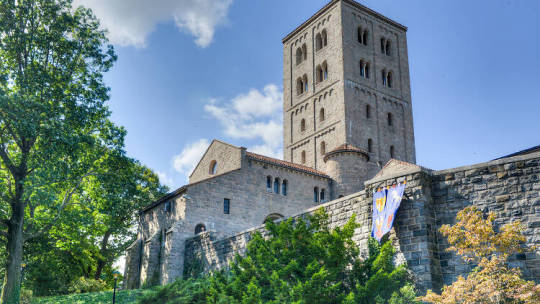
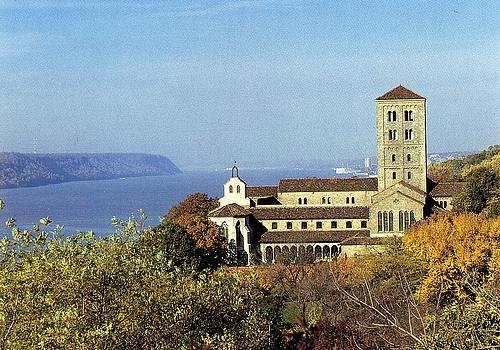
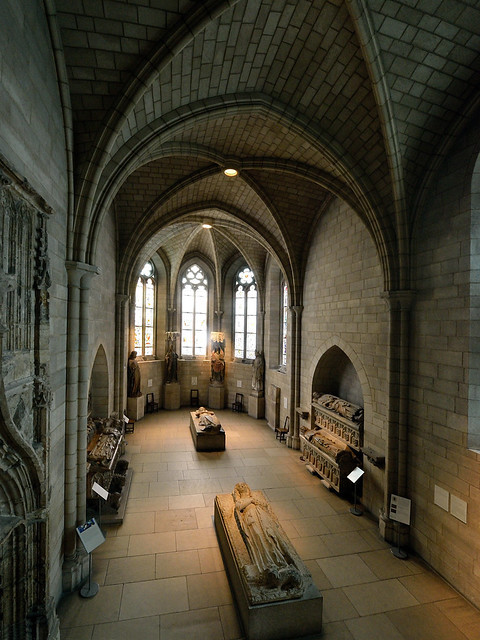
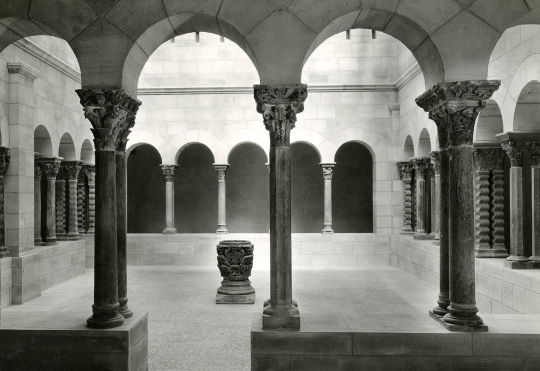
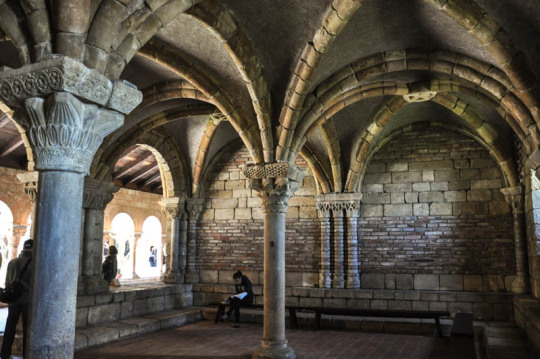
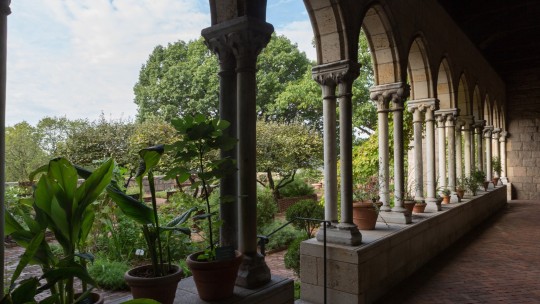
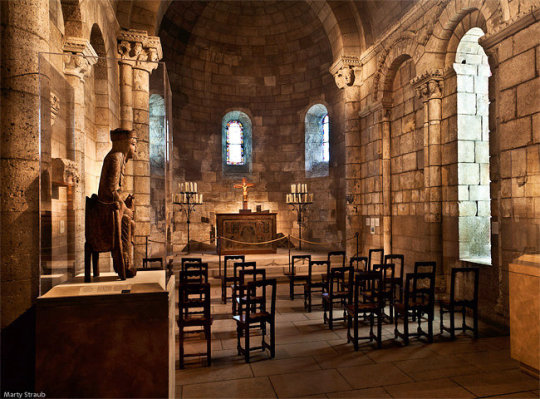

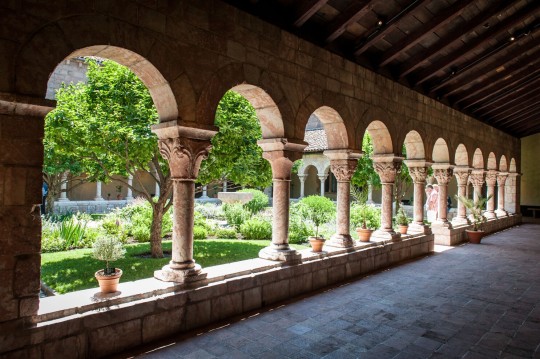
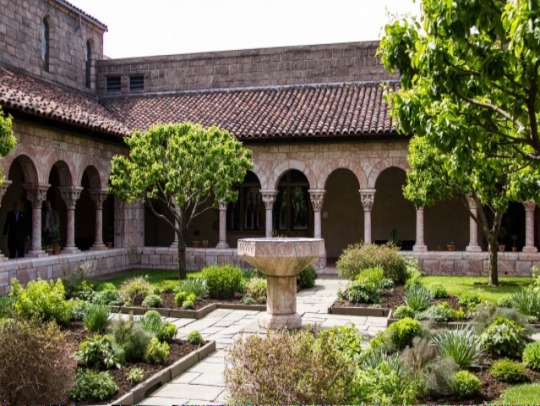
My Ministry HQ Headcanon
The original Abbey was a satellite location of the Satanic Church of the Void founded in 1635. The original Abbey structure serves as the Atelier for the Conclave of Magicians and the Poison Greenhouse. The seat of the Church was in Milan, Italy until an air raid in 1917 destroyed the building and killed the Mother Imperator and the majority of Cardinals and other officials. A new Mother Imperator was quickly elevated and the Church moved to America in 1917. The tumultuous 20s and 30s led to explosive financial growth and expansion of the Abbey into its current structure. Mobsters and other people who didn't trust the government definitely, definitely didn't funnel money into the church. Not at all.
The top of the tower is the Roost, where the Ghouls live.
My Fic List
40 notes
·
View notes
Note
I have a few, or should I say several, questions about the conversion of Europe from its various polytheistic religions to Christianity. Was it largely peaceful or violent? Were conversions voluntary or coerced initially? Was it somewhere in the middle? When it came to the idol statues, did church authorities forcibly destroy them, or did the people themselves destroy them after converting? Sorry if this is overwhelming, I didn't know who else to ask. God bless!
Ah, the conversion of Europe was a highly variable process that largely depends on where we are talking about.
Conversion to Christianity within the confines of the Roman Empire officially becomes coercive in the decades following 381, with the passing of the Edict of Thessalonica, but I think public sacrifices to the gods were being stigmatized at least since 350. That being said, while forcible conversion under threat of direct violence did occur, it probably didn't happen very frequently. Also keep in mind that by the time the coercive legislature started, a little over half of the Roman Empire was already estimated to be Christian.
Outside the Roman Empire also varies. There seems to have been very little conflict between Christians and pagans in either direction in Ireland, for example, with a pretty much completely peaceful transition to its fully Christianized state by the 560s, a little over a hundred years after the start of Saint Patrick's mission. This may have been the result of the arrival of Halley's Comet, a volcanic winter, and a plague that all happened in the 530s; Christian communities were largely monastic and slightly isolated from their pagan neighbors, and so were less affected by some of the worst forms of societal unrest.
If we look at Frankland and Scandinavia, meanwhile, we start to see a lot of top-down approaches to conversion, where ruling families are converting to Christianity and are expecting their subjects to follow suit. I would imagine there is a significant amount of coercion in this case.
As far as destruction of idols go, we do have examples of wholesale destruction of pagan sacred places (Constantine was the first to do this, in the early 300s), but this phenomenon was actually pretty muted. We do have stories of saints destroying specific idols (Saints Patrick and Boniface come to mind, but I think the historicity of both of those incidents are heavily doubted). Most temple conversions in Italy occurred in the late 600s to mid-700s, when paganism was pretty much completely dead, but apparently there was at least one pagan temple still in operation in Roman Anatolia in the mid-900s.
I would have to look in more detail for Russia and Mesopotamia - but I think the rise of Islam largely put an end to the question of mass conversion to Christianity in the latter, at least.
14 notes
·
View notes
Text
SAINTS&READING: TUESDAY, JANUARY 21, 2024
january 8_january 21
SAINT GEORGE RTHE CHOZEBITE, ABBOT (7th c.)

Saint George the Chozebite was born on the island of Cyprus toward the end of the sixth century. After the death of his parents, he went to Palestine to worship at the holy places. Here, he entered the monastic community of Chozeba between the River Jordan and Jerusalem and later became head of this monastery. Saint George presented the monk's example in fasting, vigil, and physical efforts. Having lived as an angel upon the earth, he died in peace.
VENERABLE DOMINICA OF CONSTANTINOPLE (395)

Saint Domnica came from Carthage to Constantinople in the time of the holy Emperor Theodosius the Great. Here, she was baptized by Patriarch Nectarius and entered a women’s monastery.
Through strict and prolonged ascetic effort, she attained high spiritual perfection. The saint healed the sick, demonstrated power over the natural elements, and predicted the future. By her miracles the saint moved inhabitants of the capital towards concerns about life eternal and the soul. Adorned by virtues, the saint departed this life a spotless virgin in her old age.
Source: Orthodox Church in America_OCA


Hebrews 12:25-26; 13:22-25
25 See that you do not refuse Him who speaks. For if they did not escape who refused Him who spoke on earth, much more shall we not escape if we turn away from Him who speaks from heaven, 26 whose voice then shook the earth; but now He has promised, saying, "Yet once more I shake not only the earth, but also heaven." 22 And I appeal to you, brethren, bear with the word of exhortation, for I have written to you in few words. 23 Know that our brother Timothy has been set free, with whom I shall see you if he comes shortly. 24 Greet all those who rule over you, and all the saints. Those from Italy greet you. 25 Grace be with you all. Amen.
Mark 10:2-12
2 The Pharisees came and asked Him, "Is it lawful for a man to divorce his wife?" testing Him. 3 And He answered and said to them, "What did Moses command you?" 4 They said, "Moses permitted a man to write a certificate of divorce, and to dismiss her." 5 And Jesus answered and said to them, "Because of the hardness of your heart he wrote you this precept. 6 But from the beginning of the creation, God 'made them male and female.' 7 'For this reason a man shall leave his father and mother and be joined to his wife, 8 'and the two shall become one flesh'; so then they are no longer two, but one flesh. 9 Therefore what God has joined together, let not man separate. 10 In the house His disciples also asked Him again about the same matter. 11 So He said to them, "Whoever divorces his wife and marries another commits adultery against her. 12 And if a woman divorces her husband and marries another, she commits adultery.
#orthodoxy#orthodoxchristianity#easternorthodoxchurch#originofchristianity#spirituality#holyscriptures#gospel#wisdom#bible#faith#saints
4 notes
·
View notes
Text
SAINT OF THE DAY (March 17)

On March 17, Catholics celebrate St. Patrick, the fifth-century bishop and patron of Ireland, whose life of holiness set the example for many of the Church's future saints.
St. Patrick is said to have been born around 389 AD in Britain.
Captured by Irish raiders when he was about 16, St. Patrick was taken as a slave to Ireland where he lived for six years as a shepherd before escaping and returning to his home.
At home, he studied the Christian faith at monastic settlements in Italy and in what is now modern-day France.
He was ordained a deacon around the year 418 AD by the Bishop of Auxerre, France. He was ordained a bishop in 432 AD.
It was around this time that he was assigned to minister to the small, Christian communities in Ireland, who lacked a central authority and were isolated from one another.
When St. Patrick returned to Ireland, he was able to use his knowledge of Irish culture that he gained during his years of captivity.
Using the traditions and symbols of the Celtic people, he explained Christianity in a way that made sense to the Irish and was thus very successful in converting the natives.
The shamrock, which St. Patrick used to explain the Holy Trinity, is a symbol that has become synonymous with Irish Catholic culture.
Although St. Patrick's Day is widely known and celebrated every March the world over, various folklore and legend that surround the saint can make it difficult to determine fact from fiction.
Legends falsely cite him as the man who drove away snakes during his ministry despite the climate and location of Ireland, which have never allowed snakes to inhabit the area.
St. Patrick is most revered not for what he drove away from Ireland, but for what he brought and the foundation he built for the generations of Christians who followed him.
Although not the first missionary to the country, he is widely regarded as the most successful.
The life of sacrifice, prayer and fasting has laid the foundation for the many saints that the small island was home to following his missionary work.
To this day, he continues to be revered as one of the most beloved Saints of Ireland.
In March of 2011, the Irish bishops' conference marked their patron's feast by remembering him as “pioneer in an inhospitable climate.”
As the Church in Ireland faces her own recent difficulties following clerical sex abuse scandals, comfort can be found in the plight of St. Patrick, the bishops said.
They quoted The Confession of St. Patrick, which reads:
“May it never befall me to be separated by my God from his people whom he has won in this most remote land.
I pray God that he gives me perseverance, and that he will deign that I should be a faithful witness for his sake right up to the time of my passing.”
9 notes
·
View notes
Text
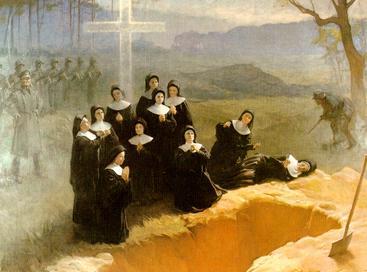
Saints of the day August 01
Bl. Thomas Welbourne, 1605 A.D. English martyr. Born in Hutton Bushel, Yorkshire, he worked as a schoolmaster until his arrest for preaching the Catholic faith. He was arrested and condemned with Blesseds John Fuithering and William Brown. He was hanged, drawn, and quartered at York. https://en.wikipedia.org/wiki/Thomas_Welbourne
The Blessed Martyrs of Nowogródek, also known as the Eleven Nuns of Nowogródek or Sister Stella and Companions were a group of Roman Catholic nuns from the Sisters of the Holy Family of Nazareth killed by the Gestapo in August 1943 in present-day Belarus.Aug 1 https://en.wikipedia.org/wiki/Martyrs_of_Nowogr%C3%B3dek#:~:text=The%20Martyrs%20of%20Nowogr%C3%B3dek%2C%20also,Gestapo%20in%20August%201943%20in
St. Almedha, sixth century. Virgin and martyr also called Aled or Filuned. The Welsh tradition reports that Almedha was the daughter of King Brychan. Having taken a vow of virginity and dedicated to Christ, Almedha fled from her father's royal residence to escape marriage to the prince of a neighboring kingdom. She went to three Welsh villages - Llandrew, Llanfillo, and Llechfaen - but the people turned her away, despite her promise warning that dreadful thing calamities would befall anyone who denied her sanctuary. Almedha reached Brecon, where she took up residence in a small hut, but the king arrived and demanded her return. When she refused him, he beheaded her. Tradition states that a spring of water appeared on the site of her murder. The three villages that refused her were visited by disasters. https://en.wikipedia.org/wiki/Saint_Eluned#:~:text=Saint%20Eluned%20(Welsh%3A%20Eiliwedd%3B,Tennyson's%20Gareth%20and%20Lynette.%22.
St. Dominic Van Honh Dieu, Roman Catholic Dominican Priest and Martyr. A native of Vietnam. He was martyred at the age of sixty-seven. Feastday Aug. 1
St. Sofia, Eastern allegory explaining the cult of Divine Wisdom, Faith, Hope, and Charity were the daughters of Wisdom (known as Sofia in the Roman Martyrology on September 30th), a widow in Rome. The daughters suffered martyrdom during Hadrian's persecution of Christians: Faith, twelve, was scourged and went unharmed when boiling pitch was poured on her, was beheaded; Hope, ten, and Charity, nine, were also beheaded after emerging unscathed, from a furnace; and Wisdom died three days later while praying at their graves. Feast day - August 1st. https://www.st-sophia.com/about/saint
St. Ethelwold. Bishop of Winchester, England, called “the Father of Monks.” Born in that city, he was ordained by St. Alphege the Bald. In 943, he joined the Benedictines at Glastonbury under St. Dunstan. He became the abbot of Abingdon in 955 and bishop in 963. Ethelwold worked with Sts. Dunstan and Oswald of York in bringing about a monastic revival after the Danish invasions. He also expelled the canons of Winchester, replacing them with monks. Ethelwold founded or restored the abbeys of Ely, Chertsey, Milton Abbas, Newminster, Peterborough, and Thorney. He authored Regularis Concordia, a monastic decree based on the Benedictine Rule, and his school of illumination at Winchester was famed. https://en.wikipedia.org/wiki/%C3%86thelwold_of_Winchester
St. Peregrinus, 643 A.D. Irish or Scottish hermit. Peregrinus was originally a pilgrim who, on his way home from a pilgrimage to Jerusalem and the holy places, chose to become a hermit in the area around Modena, Italy. He remained there for the rest of his life. https://www.bartleby.com/210/8/015.html
St. Rioch, 480 A.D. Bishop Abbot of lnisboffin, Ireland. He was a nephew of St. Patrick and the brother of Sts. Mel and two others, Melchu and Muinis. They were the sons of Conis and St. Darerca. Rioch was a missionary bishop.
ST PETER FABER, JESUIT,A roommate of Ignatius of Loyola and Francis Xavier from their university days, this gentle guide of souls was a master at giving the Spiritual Exercises. He allowed himself to be spent for the Lord and his Church, helping the Jesuits to become established all over Europe. His feast day is August 1. St Peter Faber, Jesuit - Information on the Saint of the Day - Vatican News https://www.vaticannews.va/en/saints/08/01/st-peter-faber--jesuit.html
ST. ALPHONSUS MARIA DE’ LIGUORI, ST. ALPHONSUS MARIA DE’ LIGUORI, BISHOP AND DOCTOR OF THE CHURCH, FOUNDER OF THE CONGREGATION OF THE MOST HOLY REDEEMER https://en.wikipedia.org/wiki/Alphonsus_Liguori
STS. SEVEN BROTHERS MACCABEI
6 notes
·
View notes
Text

THE DESCRIPTION OF SAINT CLARE OF ASSISI The Patron Saint of Television and Invoking for Good Weather Feast Day: August 11
"I ask to be accepted as a bride of the Lord in monastic life." -Clare (played by Dolores Hart) in 'Francis of Assisi' (1961)
The foundress of the Poor Clares, Clare was born into a noble family in Assisi, Italy in 1194. At the age of 19, enchanted by a Lenten sermon of St. Francis of Assisi, she went secretly to Portiuncula to consecrate herself to the Lord.
After she exchanged her rich gown for a plain robe and cutting off her long hair, Francis gave her sackcloth and placed her in the Benedictine convent of San Paulo, near Bastia. When her relatives came to take her back home, Clare held onto the altar and resisted their attempts, professing that she would have no other husband but Jesus Christ.
In due time, together with the other ladies, she founded a new religious order near the Church of San Damiano. The Poor Clares (Order of Saint Clare), as they are known, practiced a life of perfect poverty and strict penance. They went around barefoot, fasted every day, and never spoke except when obliged by necessity and charity.
In 1228 when Pope Gregory IX offered Clare a dispensation from the vow of strict poverty, she replied: 'I need to be absolved from my sins, but not from the obligation of following Christ.'
Accordingly, the Pope granted them the Privilegium Pauperitatis, which means, that nobody could oblige them to accept any possession.
In 1224, the army of Holy Roman Emperor Frederick II came to plunder Assisi. Clare went out to meet them with the Blessed Sacrament on her hands. Suddenly, a mysterious terror seized the enemies, who fled without harming anybody in the city.
Pope Pius XII designated Clare as the patron saint of television in 1958, on the basis that when she was too ill to attend Mass, she had reportedly been able to see and hear it on the wall of her room.
There are traditions of bringing offerings of eggs to the Poor Clares for their intercessions for good weather, particularly for weddings. This tradition remains popular in the Philippines, particularly at the Real Monasterio de Santa Clara in Quezon City and in the town of Obando, Bulacan. According to the Filipino essayist Alejandro Roces, the practice arose because of Clare's name. In Castilian, 'clara' refers to an interval of clear weather, and also to the white or albumen of the egg.
Before breathing her last in 1253 at the age of 59, Clare said: 'Blessed be you, O God, for having created me.'
©2022 photo by yours truly
#random stuff#catholic#catholic saints#franciscans#clare of assisi#clara de asis#television#poor clares
2 notes
·
View notes
Text
After decades of research as a musicologist, Craig A. Monson has heard quite a few stories. In 1986, he randomly came across a 17th-century score in a museum that piqued his interest. Although the score came from a convent of aristocratic nuns in Bologna, Italy, it was filled with explicit and obscene songs.
Monson didn’t really know much about monastic nuns in Renaissance Italy – or nuns in general – but the manuscript sure didn’t match up with his expectations. His curiosity prompted a wider search rummaging through documents of the Inquisition and the high echelons of the Church. In the archives, he found stories of nuns living full and rebellious lives – having love affairs, running for office, becoming singing divas – often without even leaving the convent walls, to which they were confined for life.
. . .
Monson’s research turned up so many anecdotes he published two books about misbehaving nuns, “Nuns Behaving Badly” and “Divas in the Convent”. We spoke to him about what life was like for women back then and the astute ways 17th-century nuns got around the many restrictions of their world.
5 notes
·
View notes
Text
Today, the Church remembers Saint Dominic (Spanish: Santo Domingo), (8 August 1170 – 6 August 1221 A.D.), a Castilian priest and founder of the Dominican Order.
Ora pro nobis.
In the earliest narrative source, by Jordan of Saxony, Dominic's parents are named Felix Guzman and Juanna of Aza. The story is told that before his birth his barren mother made a pilgrimage to the Abbey at Silos, and dreamt that a dog leapt from her womb carrying a flaming torch in its mouth, and "seemed to set the earth on fire." This story drew resonance from the fact that his order became known, after his name, as the Dominican order, Dominicanus in Latin which a play on words interpreted as Domini canis: "Dog of the Lord." Jordan adds that Dominic was brought up by his parents and a maternal uncle who was an archbishop.
The failure to name his parents is not unusual, since Jordan wrote a history of the Order's early years, rather than a biography of Dominic. A later source, still of the 13th century, also gives their names as Juana and Felix. Nearly a century after Dominic's birth, a local author asserted that Dominic's father was "vir venerabilis et dives in populo suo" ("an honoured and wealthy man in his village"). The travel narrative of Pero Tafur, written circa 1439 (about a pilgrimage to Dominic's tomb in Italy), states that Dominic's father belonged to the family de Guzmán, and that his mother belonged to the Aça or Aza family.
Dominic was educated in the schools of Palencia (they became a university soon afterwards) where he devoted six years to the arts and four to theology. In 1191, when Spain was desolated by famine, young Dominic gave away his money and sold his clothes, furniture and even precious manuscripts to feed the hungry. Dominic reportedly told his astonished fellow students, "Would you have me study off these dead skins, when men are dying of hunger?" In 1194, around age twenty-five, Dominic joined the Canons Regular in the canonry in the Cathedral of Osma, following the rule of Saint Augustine.
Around 1205, Dominic, along with Diego de Acebo, began a program in the south of France, to convert the Cathars, a Christian religious sect with gnostic and dualistic beliefs, which the Roman Catholic Church deemed heretical. As part of this, Catholic-Cathar public debates were held at Verfeil, Servian, Pamiers, Montréal and elsewhere. Dominic concluded that only preachers who displayed real sanctity, humility and asceticism could win over convinced Cathar believers. However, even Dominic managed only a few converts among the Cathars.
In 1215, Dominic established himself, with six followers, in a house given by Peter Seila, a rich resident of Toulouse. Dominic saw the need for a new type of organization to address the spiritual needs of the growing cities of the era, one that would combine dedication and systematic education, with more organizational flexibility than either monastic orders or the secular clergy. He subjected himself and his companions to the monastic rules of prayer and penance; and meanwhile Bishop Foulques gave them written authority to preach throughout the territory of Toulouse.
In the same year, the year of the Fourth Lateran Council, Dominic and Foulques went to Rome to secure the approval of the Pope, Innocent III. Dominic returned to Rome a year later, and was finally granted written authority in December 1216 and January 1217 by the new pope, Honorius III for an order to be named "The Order of Preachers" ("Ordo Praedicatorum", or "O.P.," popularly known as the Dominican Order).
Blessed Cecilia Caesarini, who was received by Dominic into his new order, in her old age described him as "...thin and of middle height. His face was handsome and somewhat fair. He had reddish hair and beard and beautiful eyes ... His hands were long and fine and his voice pleasingly resonant. He never got bald, though he wore the full tonsure, which was mingled with a few grey hairs."
Although he traveled extensively to maintain contact with his growing brotherhood of friars, Dominic made his headquarters in Rome. In 1219, Pope Honorius III invited Dominic and his companions to take up residence at the ancient Roman basilica of Santa Sabina, which they did by early 1220. Before that time the friars had only a temporary residence in Rome at the convent of San Sisto Vecchio, which Honorius III had given to Dominic circa 1218, intending it to become a convent for a reformation of nuns at Rome under Dominic's guidance. The official foundation of the Dominican convent at Santa Sabina with its studium conventuale, the first Dominican studium in Rome, occurred with the legal transfer of property from Pope Honorius III to the Order of Preachers on 5 June 1222, though the brethren had taken up residence there already in 1220. The studium at Santa Sabina was the forerunner of the studium generale at Santa Maria sopra Minerva. The latter would be transformed in the 16th century into the College of Saint Thomas and then in the 20th century into the Pontifical University of Saint Thomas Aquinas, Angelicum sited at the convent of Saints Dominic and Sixtus.
In the winter of 1216–1217, at the house of Ugolino de' Conti, he first met William of Montferrat, Dominican friar, afterwards a close friend. According to Guiraud, Dominic abstained from meat, "observed stated fasts and periods of silence", "selected the worst accommodations and the meanest clothes", and "never allowed himself the luxury of a bed". "When travelling, he beguiled the journey with spiritual instruction and prayers". Guiraud also states that Dominic frequently traveled barefoot and that "rain and other discomforts elicited from his lips nothing but praises to God".
Dominic arrived in Bologna on 21 December 1218. A convent was established at the Mascarella church by the Blessed Reginald of Orleans. Soon afterwards they had to move to the church of San Nicolò of the Vineyards. Dominic settled in this church and held here the first two General Chapters of the order.
Dominic died at the age of fifty-one, according to Guiraud "exhausted with the austerities and labours of his career". He had reached the convent of St Nicholas at Bologna, Italy, "weary and sick with a fever". Guiraud states that Dominic "made the monks lay him on some sacking stretched upon the ground" and that "the brief time that remained to him was spent in exhorting his followers to have charity, to guard their humility, and to make their treasure out of poverty". He died at noon on 6 August 1221. His body was moved to a simple sarcophagus in 1233. Under the authority of Pope Gregory IX, Dominic was canonized in 1234.
O God of the prophets, you opened the eyes of your servant Dominic to perceive a famine of hearing the word of the Lord, and moved him, and those he drew about him, to satisfy that hunger with sound preaching and fervent devotion: Make your Church, dear Lord, in this and every age, attentive to the hungers of the world, and quick to respond in love to those who are perishing; through Jesus Christ our Lord, who lives and reigns with you and the Holy Spirit, one God, forever and ever.
Amen.
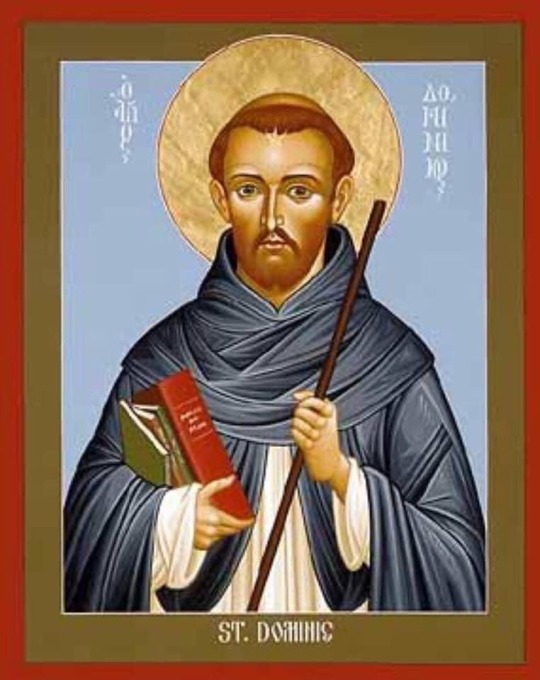
2 notes
·
View notes
Text
Events 12.28 (before 1940)
418 – A papal election begins, resulting in the election of Pope Boniface I. 457 – Majorian is acclaimed as Western Roman emperor. 484 – Alaric II succeeds his father Euric and becomes king of the Visigoths. He establishes his capital at Aire-sur-l'Adour (Southern Gaul). 893 – An earthquake destroys the city of Dvin, Armenia. 1065 – Edward the Confessor's Romanesque monastic church at Westminster Abbey is consecrated. 1308 – The reign of Emperor Hanazono of Japan begins. 1659 – The Marathas defeat the Adilshahi forces in the Battle of Kolhapur. 1768 – King Taksin's coronation achieved through conquest as a king of Thailand and established Thonburi as a capital. 1795 – Construction of Yonge Street, formerly recognized as the longest street in the world, begins in York, Upper Canada (present-day Toronto). 1832 – John C. Calhoun becomes the first Vice President of the United States to resign. He resigned after being elected Senator from South Carolina. 1835 – Osceola leads his Seminole warriors in Florida into the Second Seminole War against the United States Army. 1836 – South Australia and Adelaide are founded. 1836 – Spain recognizes the independence of Mexico with the signing of the Santa María–Calatrava Treaty. 1846 – Iowa is admitted as the 29th U.S. state. 1879 – Tay Bridge disaster: The central part of the Tay Rail Bridge in Dundee, Scotland, United Kingdom collapses as a train passes over it, killing 75. 1885 – Indian National Congress, a political party of India, is founded in Bombay Presidency, British India. 1895 – The Lumière brothers perform for their first paying audience at the Grand Cafe in Boulevard des Capucines. 1895 – Wilhelm Röntgen publishes a paper detailing his discovery of a new type of radiation, which later will be known as x-rays. 1902 – The Syracuse Athletic Club defeat the New York Philadelphians, 5–0, in the first indoor professional football game, which was held at Madison Square Garden. 1908 – The 7.1 Mw Messina earthquake shakes Southern Italy with a maximum Mercalli intensity of XI (Extreme), killing between about 80,000. 1912 – The first municipally owned streetcars take to the streets in San Francisco. 1918 – Constance Markievicz, while detained in Holloway prison, becomes the first woman to be elected Member of Parliament (MP) to the British House of Commons.
0 notes
Text
Religious Tourism: Exploring Sacred Sites Around the World

Religious tourism, also known as faith tourism, attracts millions of travellers each year to destinations steeped in spiritual significance. These journeys are not just about sightseeing; they offer pilgrims and travellers a chance to connect deeply with their faith, culture, and history. Here is a look at some of the world’s most revered religious tourism sites, showcasing their cultural and spiritual importance.
Mecca, Saudi Arabia
Mecca is the holiest city in Islam and the birthplace of the Prophet Muhammad. Every year, millions of Muslims participate in the Hajj pilgrimage, fulfilling one of the Five Pillars of Islam. The Kaaba, located in the Masjid al-Haram mosque, is the focal point of Islamic worship and prayer. Visiting Mecca is a once-in-a-lifetime obligation for all able-bodied Muslims who can afford the journey.
The Vatican City, Rome, Italy
As the heart of the Roman Catholic Church, the Vatican City is a major pilgrimage destination. Home to St. Peter’s Basilica, the Sistine Chapel, and the Vatican Museums, it offers both spiritual enrichment and artistic inspiration. The Pope’s public appearances and blessings attract pilgrims from around the globe.
Varanasi, India
One of the oldest continuously inhabited cities in the world, Varanasi holds immense spiritual significance for Hindus. Located on the banks of the Ganges River, it is believed to be a gateway to liberation from the cycle of life and death. The city’s ghats, such as Dashashwamedh and Manikarnika, are centers for prayers, rituals, and cremations.
Jerusalem, Israel
Jerusalem is a sacred city for Judaism, Christianity, and Islam. Sites like the Western Wall, the Church of the Holy Sepulchre, and the Dome of the Rock attract millions of visitors annually. The city’s rich history and religious diversity make it a unique spiritual hub.
Lumbini, Nepal
Lumbini is the birthplace of Siddhartha Gautama, who became the Buddha. It is one of the most important pilgrimage sites for Buddhists. The Maya Devi Temple, monastic zones, and Ashokan Pillar draw visitors seeking peace and enlightenment.
Bodh Gaya, India
Another prominent Buddhist site, Bodh Gaya is where Buddha attained enlightenment under the Bodhi Tree. The Mahabodhi Temple complex is a UNESCO World Heritage site and a magnet for devotees and spiritual seekers.
Kashi Vishwanath Temple, India
Dedicated to Lord Shiva, this temple in Varanasi is one of the most famous Hindu shrines. Its spiritual ambiance and rituals attract millions of devotees, especially during the Maha Shivaratri festival.
Mount Kailash, Tibet
Mount Kailash is sacred to Hindus, Buddhists, Jains, and Bon adherents. Pilgrims undertake the challenging circumambulation (kora) around the mountain, believed to bring spiritual purification and enlightenment.
Canterbury, England
The Canterbury Cathedral is a key site in Christian pilgrimage history, famously connected to Saint Thomas Becket. Chaucer’s Canterbury Tales immortalized the tradition of pilgrimage to this historic English city.
Medjugorje, Bosnia and Herzegovina
Known for the reported apparitions of the Virgin Mary since 1981, Medjugorje has become a spiritual destination for Catholics. Pilgrims visit to experience its prayerful atmosphere and participate in religious events.
Shwedagon Pagoda, Myanmar
The Shwedagon Pagoda is one of Buddhism’s most sacred sites, housing relics of four Buddhas. The golden stupa dominates Yangon’s skyline and is a centre for meditation and religious ceremonies.
Amritsar, India
The Golden Temple, also known as Harmandir Sahib, is the holiest site in Sikhism. Its stunning golden architecture, serene Amrit Sarovar (holy pool), and the daily langar (community meal) embody the principles of equality and service.
Conclusion
Religious tourism offers an opportunity to explore humanity’s diverse spiritual heritage. Whether seeking personal enlightenment, cultural understanding, or historical insight, these sacred sites provide profound experiences that transcend borders and beliefs. As you plan your next journey, consider the spiritual and cultural treasures these destinations have to offer.
Get your reservations here:
0 notes
Text
What role did Giordano Bruno play in the development of the scientific method?

Introduction
Giordano Bruno was an Italian philosopher, mathematician, and astronomer whose ideas significantly influenced the development of the scientific method. Although he is often remembered for his tragic death at the stake, his intellectual contributions laid crucial groundwork for modern science. Bruno's work encompassed a wide range of subjects, including cosmology, metaphysics, and the nature of the universe, which ultimately challenged the prevailing scientific and religious dogmas of his time.
Early Life and Education
Born in 1548 in Nola, Italy, Giordano Bruno entered the Dominican Order at a young age. His education in the monastery provided him with a foundation in Aristotelian philosophy and the theological teachings of the Catholic Church. However, Bruno's insatiable curiosity and intellectual independence led him to question many of the established doctrines. By the late 1570s, Bruno had abandoned monastic life and began traveling across Europe, engaging with various intellectual communities and developing his ideas.
Cosmological Theories
Infinite Universe and Multiple Worlds
One of Bruno's most radical contributions was his theory of an infinite universe. He argued that the universe had no center and no boundaries, proposing that it contained countless stars, each possibly hosting its own planetary systems. This idea directly challenged the geocentric model of the universe endorsed by the Catholic Church and the Ptolemaic system, which placed the Earth at the center of the cosmos.
Bruno's concept of an infinite universe also introduced the idea of multiple worlds, suggesting that the stars were other suns with their own planets, some of which could harbor life. This notion was revolutionary, as it implied that Earth was not unique or central to God's creation. Bruno's ideas paved the way for later astronomers, such as Johannes Kepler and Galileo Galilei, who expanded on the heliocentric model of the solar system initially proposed by Copernicus.
Homogeneity of the Universe
Bruno proposed that the same physical laws and materials applied throughout the universe. This concept of homogeneity suggested that the principles governing the Earth and the heavens were not distinct but part of a unified, natural system. This idea was instrumental in moving away from Aristotelian and Ptolemaic cosmologies, which held that the heavens were made of a different, unchangeable substance.
Philosophical Contributions
Pantheism
Bruno's cosmological theories were deeply intertwined with his philosophical beliefs. He was a proponent of pantheism, the idea that God and the universe were identical. According to Bruno, God was not a distinct, transcendent entity but was immanent within the infinite universe. This belief further undermined the traditional Christian view of a personal, interventionist God and suggested a more abstract, naturalistic understanding of divinity.
Epistemology and the Quest for Knowledge
Bruno emphasized the importance of empirical observation and critical thinking in the pursuit of knowledge. He believed that true understanding could only be achieved through a combination of sensory experience and rational analysis. This approach contrasted sharply with the scholasticism of his time, which relied heavily on the authority of ancient texts and the Church.
Bruno's epistemological stance laid the groundwork for the scientific method, which prioritizes observation, experimentation, and the questioning of established doctrines. His insistence on the fallibility of human knowledge and the continuous search for truth resonated with later scientists and philosophers, including Francis Bacon and René Descartes.
Bruno's Influence on the Scientific Method
Challenging Authority
Giordano Bruno's willingness to challenge established authorities and question prevailing dogmas was a critical aspect of his contribution to the development of the scientific method. By rejecting the geocentric model and promoting a heliocentric and infinite universe, Bruno demonstrated the importance of skepticism and the willingness to reconsider long-held beliefs in light of new evidence.
This spirit of critical inquiry and independence of thought became foundational to the scientific revolution. Figures like Galileo, Kepler, and Newton were inspired by Bruno's example to pursue their research, even when it contradicted traditional views and faced significant opposition.
Integrating Philosophy and Science
Bruno's integration of philosophy and science also played a crucial role in the development of the scientific method. He viewed scientific inquiry as a means of exploring profound metaphysical questions about the nature of reality and the universe. This holistic approach encouraged a more comprehensive understanding of the natural world, combining empirical investigation with philosophical reflection.
By advocating for a unified approach to knowledge, Bruno influenced the way scientists approached their work, promoting an interdisciplinary perspective that remains vital in modern scientific research.
Bruno's Legacy and Giordano Bruno's Last Words
Martyrdom and Impact
Giordano Bruno's commitment to his ideas ultimately led to his execution. In 1593, he was arrested by the Roman Inquisition on charges of heresy, blasphemy, and immoral conduct. After a lengthy trial, Bruno was condemned to death and burned at the stake in 1600. His refusal to recant his beliefs, even in the face of death, made him a martyr for intellectual freedom and the pursuit of truth.
Giordano Bruno's last words are often cited as a testament to his unwavering dedication to his ideas. While the exact phrasing is not definitively recorded, it is believed that he responded to his sentence by saying, "Perhaps you, my judges, pronounce this sentence against me with greater fear than I receive it." These words reflect Bruno's courage and conviction, underscoring his role as a pioneering thinker who challenged the status quo.
Influence on Later Thinkers
Bruno's ideas continued to influence subsequent generations of scientists and philosophers. His vision of an infinite universe and the possibility of multiple worlds inspired later astronomers to explore the cosmos with renewed vigor. The emphasis on empirical observation and critical thinking that Bruno championed became central to the scientific method, shaping the work of key figures in the scientific revolution.
Bruno's integration of philosophy and science also resonated with later thinkers. His pantheistic view of the universe influenced the development of modern philosophical and scientific thought, encouraging a more holistic and interconnected understanding of reality.
Keytostudy and Modern Educational Approaches
In contemporary times, the principles that Bruno advocated—critical thinking, empirical observation, and the integration of knowledge—are reflected in modern educational methodologies and resources. Websites like Keytostudy, which are dedicated to improving memory, speed reading, visualization, and research skills, embody the spirit of Bruno's intellectual legacy. These platforms emphasize the importance of continuous learning, the application of scientific methods to enhance cognitive abilities, and the pursuit of knowledge across disciplines.
By providing tools and techniques to improve mental performance, Keytostudy and similar resources contribute to the development of a more informed and capable society. They promote the values of intellectual curiosity and rigorous inquiry that were central to Bruno's work, ensuring that his legacy continues to inspire and inform new generations of learners.
Conclusion
Giordano Bruno played a pivotal role in the development of the scientific method through his revolutionary cosmological theories, philosophical contributions, and unwavering commitment to intellectual freedom. His ideas challenged the established order and laid the groundwork for the scientific revolution, influencing key figures in the history of science.
Bruno's emphasis on empirical observation, critical thinking, and the integration of knowledge remains relevant today, shaping modern educational approaches and resources like Keytostudy. His legacy as a martyr for truth and a pioneer of scientific thought continues to inspire those who seek to understand the universe and advance human knowledge.
0 notes
Text
SAINTS&READING: FRIDAY, OCTOBER 25, 2024
october 12_october 26
St MARTIN THE MERCIFUL, BISHOP OF TOURS (France_397)

Saint Martin the Merciful, Bishop of Tours, was born at Sabaria in Pannonia (modern Hungary) in 316. Since his father was a Roman officer, he also was obliged to serve in the army. Martin did so unwillingly, for he considered himself a soldier of Christ, though he was still a catechumen.
At the gates of Amiens, he saw a beggar shivering in the severe winter cold, so he cut his cloak in two and gave half to the beggar. That night, the Lord Jesus Christ appeared to the saint wearing Martin’s cloak. He heard the Savior say to the angels surrounding Him, “Martin is only a catechumen, but he has clothed Me with this garment.” The saint was baptized soon after this, and reluctantly remained in the army.
Two years later, the barbarians invaded Gaul and Martin asked permission to resign his commission for religious reasons. The commander charged him with cowardice. Saint Martin demonstrated his courage by offering to stand unarmed in the front line of battle, trusting in the power of the Cross to protect him. The next day, the barbarians surrendered without a fight, and Martin was allowed to leave the army.
He traveled to various places during the next few years, spending some time as a hermit on an island off Italy. He became friendly with Saint Hilary, Bishop of Poitiers (January 14), who made Martin an exorcist. After several years of the ascetic life, Saint Martin was chosen to be Bishop of Tours in 371. As bishop, Saint Martin did not give up his monastic life, and the place where he settled outside Tours became a monastery. In fact, he is regarded as the founder of monasticism in France. He conversed with angels, and had visions of Saints Peter and Paul (June 29) and of other saints. He is called the Merciful because of his generosity and care for the poor, and he received the grace to work miracles.
After a life of devoted service to Christ and His Church, the saint fell ill at Candes, a village in his diocese, where he died on November 8, 397. He was buried three days later (his present Feast) at Tours. During the Middle Ages, many Western churches were dedicated to Saint Martin, including Saint Martin’s in Canterbury, and Saint Martin-in-the-Fields in London.
In 1008, a cathedral was built at Tours over the relics of Saint Martin. This cathedral was destroyed in 1793 during the French Revolution, together with the relics of Saint Martin and Saint Gregory of Tours (November 17). A new cathedral was built on the site many years later. Some fragments of the relics of Saint Martin were recovered and placed in the cathedral, but nothing remains of Saint Gregory’s relics.
Saint Martin’s name appears on many Greek and Russian calendars. His commemoration on October 12 in the Russian calendar seems to be an error since ancient sources give the November date.
VENERABLE SYMEON, THE NEW THEOLOGIAN (1021)

Saint Simeon the New Theologian was born in 949 in Galatea (Paphlagonia) and educated at Constantinople. His father prepared him for a career in court, and the youth occupied a high position in the imperial court for a while. When he was fourteen, he met the renowned Elder Simeon the Pious at the Studion Monastery, who would majorly influence his spiritual development. He remained in the world for several years, preparing himself for the monastic life under the Elder’s guidance, and finally entered the monastery at the age of 27.
Saint Simeon the Pious recommended to the young man the writings of Saint Mark the Ascetic (March 5) and other spiritual writers. He read these books attentively and tried to put into practice what he read. Three points made by Saint Mark in his work “On the Spiritual Law” (see Vol. I of the English Philokalia) particularly impressed him. First, you should listen to your conscience and do what it tells you if you wish your soul to be healed (Philokalia, p. 115). Second, only by fulfilling the commandments can one obtain the activity of the Holy Spirit. Thirdly, one who prays only with the body and without spiritual knowledge is like the blind man who cried out, “Son of David, have mercy upon me” (Luke 18:38) (Philokalia, p. 111). When the blind man received his sight, however, he called Christ the Son of God (John 9:38).
Saint Simeon was wounded with a love for spiritual beauty, and tried to acquire it. In addition to the Rule given him by his Elder, his conscience told him to add a few more Psalms and prostrations, and to repeat constantly, “Lord Jesus Christ, have mercy upon me.” Naturally, he heeded his conscience.
During the day, he cared for the needs of people living in the palace of Patricius. At night, his prayers grew longer and he remained praying until midnight. Once, as he was praying in this way, a most brilliant divine radiance descended upon him and filled the room. He saw nothing but light all around him, and he was not even aware of the ground beneath his feet.
It seemed to him that he himself became light. Then his mind rose upward to the heavens, and he saw a second light brighter than the light which surrounded him. Then, on the edge of this second light, he seemed to see Saint Simeon the Pious, who had given him Saint Mark the Ascetic to read.
Seven years after this vision, Saint Simeon entered the monastery. There he increased his fasting and vigilance, and learned to renounce his own will.
The Enemy of our salvation stirred up the brethren of the monastery against Saint Simeon, who was indifferent to the praises or reproaches of others. Because of the increased discontent in the monastery, Saint Simeon was sent to the Monastery of Saint Mamas in Constantinople.
There he was tonsured into the monastic schema, and increased his spiritual struggles. He attained to a high spiritual level, and increased his knowledge of spiritual things through reading the Holy Scriptures and the writings of the Fathers, as well as in conversation with holy Elders.
Around the year 980, Saint Simeon was made igumen of the monastery of Saint Mamas and continued in this office for twenty-five years. He repaired and restored the monastery, which had suffered from neglect, and also brought order to the life of the monks.
The strict monastic discipline, for which Saint Simeon strove, led to great dissatisfaction among the brethren. Once, after Liturgy, some of the monks attacked him and nearly killed him. When the Patriarch of Constantinople expelled them from the monastery and wanted to hand them over to the civil authorities, Saint Simeon asked that they be treated with leniency and be permitted to live in the world.
About the year 1005, Saint Simeon resigned his position as igumen in favor of Arsenius, while he himself settled near the monastery in peace. There he composed his theological works, portions of which appear in the Philokalia.
The chief theme of his works is the hidden activity of spiritual perfection, and the struggle against the passions and sinful thoughts. He wrote instructions for monks: “Theological and Practical Chapters,” “A Treatise on the Three Methods of Prayer,” (in Vol. IV of the English Philokalia) and “A Treatise on Faith.” Moreover, Saint Simeon was an outstanding church poet. He also wrote “Hymns of Divine Love,” about seventy poems filled with profound prayerful meditations.
The sublime teachings of Saint Simeon about the mysteries of mental prayer and spiritual struggle have earned him the title “the New Theologian.” These teachings were not the invention of Saint Simeon, but they had merely been forgotten over time.
Some of these teachings seemed unacceptable and strange to his contemporaries. This led to conflict with Constantinople’s church authorities, and Saint Simeon was banished from the city. He withdrew across the Bosphorus and settled in the ancient monastery of Saint Makrina.
The saint peacefully fell asleep in the Lord in the year 1021. During his life he received the gift of working miracles. Numerous miracles also took place after his death; one of them was the miraculous discovery of his icon.
His Life was written by his cell-attendant and disciple, Saint Nicetas Stethatos.
Since March 12 falls during Great Lent, Saint Simeon’s Feast is transferred to October 12.


Ephesians 6:18-24
18 praying always with all prayer and supplication in the Spirit, being watchful to this end with all perseverance and supplication for all the saints- 19 and for me, that utterance may be given to me, that I may open my mouth boldly to make known the mystery of the gospel, 20 for which I am an ambassador in chains; that in it I may speak boldly, as I ought to speak. 21 But that you also may know my affairs and how I am doing, Tychicus, a beloved brother, and faithful minister in the Lord, will make all things known to you; 22 whom I have sent to you for this very purpose, that you may know our affairs, and that he may comfort your hearts. 23 Peace to the brethren, and love with faith, from God the Father and the Lord Jesus Christ. 24 Grace be with all those who love our Lord Jesus Christ sincerely. Amen.
Luke 9:12-18
12 When the day began to wear away, the twelve came and said to Him, "Send the multitude away, that they may go into the surrounding towns and country, and lodge and get provisions; for we are in a deserted place here." 13 But He told them, "You give them something to eat." And they said, "We have no more than five loaves and two fish unless we go and buy food for all these people." 14 For there were about five thousand men. Then He said to His disciples, "Make them sit down in groups of fifty." 15 And they did so and made them all sit down. 16 Then He took the five loaves and the two fish, and looking up to heaven, He blessed and broke them, and gave them to the disciples to set before the multitude. 17 So they all ate and were filled, and they took twelve baskets of the leftover fragments. 18 And it happened, as He was alone praying, that His disciples joined Him,
#orthodoxy#orthodoxchristianity#easternorthodoxchurch#originofchristianity#spirituality#holyscriptures#gospel#bible#wisdom#faith#saints
3 notes
·
View notes
Text
SAINT OF THE DAY (June 9)

On June 9, the Catholic Church commemorates the sixth-century Irish monk and missionary, Saint Columba of Iona, also known as St. Columcille.
One of Ireland's three patron saints (together with Saint Patrick and Saint Brigid), he is also sometimes called the “Apostle of the Picts” for his evangelization of Scotland.
He should not be confused with St. Columbanus (or Columban), a different Irish monk and missionary who lived slightly later and ended up in Italy.
Columba was born during 521, descended from royalty through his father.
He was taught and mentored by the priest who baptized him. He later attended a monastic school founded by Saint Finnian of Moville.
His own life as a monk began at the school where he was also ordained a deacon.
The deacon went on to spend time in a different monastery and school run by another Finnian, Saint Finnian of Clonard.
Columba became a priest during this period, and along with eleven others from this same institution, he would be known as one of the “Twelve Apostles of Ireland.”
Columba also studied with Saint Mobhi of Glasnevin, before a disease epidemic forced him to return to his ancestral homeland of Ulster during 544.
He spent the next 15 years traveling, preaching, and founding monasteries.
In 563, it is not clear why Columba left Ireland. By some accounts, he was simply going to preach the word of God.
Others claim that he had become involved in a battle between warring tribes, before repenting and taking on foreign missionary work as a penance.
On the island of Iona, located on Scotland’s northwest coast, Columba and his group of companions built simple monastic quarters and a church for themselves.
The priest-monk’s first missionary work was in the region of Dalriada, whose Celtic Christian inhabitants were lacking solid religious instruction.
His next effort was to convert the Picts of northern Scotland, a task that would take up most of the rest of his life.
He began by gaining entrance to the castle of King Brude, where the locked gates are said to have miraculously opened when the sign of the Cross was made.
The king welcomed the missionaries, believed the Gospel, and was baptized.
Columba’s evangelization of northern Scotland continued over the next three decades.
He and his companions met with some resistance from the native pagan Druids, but on the whole, they found remarkable success in spreading the Catholic faith and building up a network of churches and monasteries.
The island monastery at Iona remained his home base. It drew pilgrims looking to benefit from the priest-monk’s wisdom and his prayers.
He remained in touch with the Irish Church, making many trips back until he became too weak to travel.
Even in old age, Columba maintained an intense routine of prayer, fasting, and study.
After giving a final blessing to his monastery on 8 June 597, he died sometime in the early hours of the following day.
#Saint of the Day#Saint Columba of Iona#St. Columcille#Apostle of the Picts#Twelve Apostles of Ireland
4 notes
·
View notes
Text
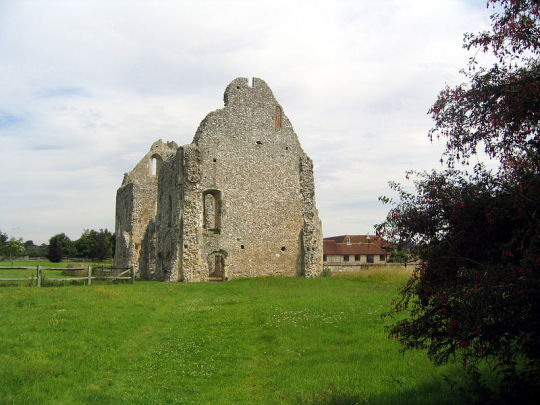
SAINTS NOVEMBER 10 "There is only one tragedy in this life, not to have been a saint."- Leon Bloy
St. John of Ratzeburg, 1066 A.D. Martyred Scottish bishop. Born in Scotland, John became a missionary in Germany. Named the bishop of Ratzeburg, he labored on the coast of the Baltic Sea where he was martyred for the faith by local pagans.
St. Justus of Canterbury, 627 A.D. Benedictine archbishop of Canterbury. Justus was a Roman sent by Pope St. Gregory I the Great in 601 to England, to evangelize the Anglo-Saxons. Justus and others were sent as aides to St. Augustine. In 604, Justus was consecrated the first bishop of Rochester. The death of King Ethelbert in 616 caused a rise in paganism, and Justus returned to Rome. In the following year he went back to England and became archbishop of Canterbury in 624. He consecrated St. Paulinus.
St. Elaeth, 1084 A.D. British king driven by locals into Wales. He became a monk there under St. Seiriol. Elaeth’s poems have survived.
St. Aedh MacBricc, 589 A.D. Miracle worker and founder who reputedly cured St. Brigid of a headache. Aedh was the son of Bricc, or Breece, of the Hy Neill. He was robbed of his inheritance by his brother and came under the influence of bishop Illathan of Rathlihen, Offay. Admitted into the monastic life, Aedh founded a religious community in Westmeath. He is listed in some records as a bishop.
St. Theoctiste of Lesbos, Roman Catholic Nun and hermitess. According to tradition, she lived on the island of Lesbos in the Aegean Sea before being kidnapped by Arab raiders. They took her to the island of Paros where she escaped and lived thereafter for thirty years as a herrmitess. Discovered one day by a hunter named Simon, she begged him to return when he could with Holy Communion, a plea he fulfilled a year later after which she soon died. Nov 10
ST. ANDREW AVELLINO, THEATINE, PRIEST
St. Leo the Great, Pope Leo I (c. 400 – 10 November 461), also known as Saint Leo the Great, was the head of the Catholic Church from 29 September 440 to his death in 461. Benedict XVI has called Pope St Leo the Great “one of the greatest Popes who have honoured the Roman See. Leo lived in the fifth century, and is known to history for his role in calling the Council of Chalcedon, and for having forestalled Attila the Hun’s invasion of Italy. https://www.vaticannews.va/en/saints/11/10/st--leo-the-great--pope-and-doctor-of-the-church.html
1 note
·
View note
Text

THE DESCRIPTION OF SAINT HENRY II, THE HOLY ROMAN EMPEROR Feast Day: July 13
Henry II, also known as Henry the Exuberant, was born on May 6, 973 AD in Bavaria, Germany, Holy Roman Empire, and is the son of Henry II of Bavaria and Gisela of Burgundy. He was Henry I of Bavaria's grandson through his father, and is the great-grandson of Henry the Fowler. On his mother's side, he was the grandson of Conrad the Peaceful, and the great-grandson of King Rudolph II of Burgundy.
He was educated in the Christian faith by Wolfgang of Regensburg during his father's exile, and studied at Hildesheim Cathedral. The Emperor himself ensured the younger Henry received an ecclesiastical education in order that by becoming a religious official he would be prevented from participating in the Imperial government.
The death of Otto II in 983 allowed the elder Henry to be released from custody and to return from exile. The elder Henry claimed regency over Otto III, the three-year-old child of Otto II. After a failed attempt to claim the German throne for himself in 985, the elder Henry relinquished the regency to the child's mother Theophanu.
In return for his submission to the child king, Henry was restored as Duke of Bavaria. The younger Henry, now thirteen years old, was named his regent over Bavaria. When the elder Henry died in 995, the younger Henry was elected by the Bavarian nobles as the new duke to succeed his father.
Sincerely religious, Henry II supported service to the Church (he was celibate) and promoted various monastic reforms. He also strongly enforced clerical celibacy, perhaps partly in order that the public land and offices he granted to clerics would not be devised to heirs. He encouraged the reform of the Church, fostered missionary activity, and made several charitable foundations for the poor.
Wished to become a monk, and in virtue of his imperial power he ordered the Abbot of Verdun to accept him in his monastery. Thereupon, the Abbot ordered him, in virtue of the vows he had professed, to continue the administration of the empire. Henry II fulfilled his duties in the spirit of humility and service, being convinced that temporal power was given by God for the good of the people.
He succeeded in persuading Pope Benedict VIII to include the word 'Filioque' in the Nicene Creed. The addition of the term provided that the Holy Spirit emanated from both God the Father and God the Son.
Together with the concept of Papal primacy, dispute over this doctrine was one of the primary causes of the Great Schism of the Church in 1054.
Henry II inherited several unresolved ecclesiastical disputes from his predecessor Otto III. Issues of particular importance were the reestablishment of the Diocese of Merseburg and the settlement of the Gandersheim Conflict.
Returning to Magdeburg, Germany from southern Italy to celebrate Easter, he fell ill in Bamberg. After celebrating Easter, Henry retired to his imperial palace in Göttingen, and died there on July 13, 1024 at the age of 51, without an heir, and thus Henry II is the last of the Saxon kings.
Henry II is canonized as a saint by Pope Eugenius III in July 1147; while Cunigunde of Luxembourg, his spouse, was canonized on March 29, 1200 by Pope Innocent III. Henry's relics were carried on campaigns against heretics in the 1160s.
He is the patron saint of the city of Basel, Switzerland, and of St. Henry's Marist Brothers' College in Durban, South Africa. During his lifetime, Henry II became an oblate of the Benedictine Order, and today is venerated within the Order as the patron saint of all oblates, along with St. Frances of Rome.
#random stuff#catholic#catholic saints#henry ii#saint henry#san enrique#san enrique ii#enrique II de alemania#henry the exuberant#holy roman emperor#benedictines
0 notes